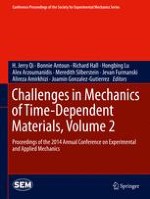Challenges in Mechanics of Time-Dependent Materials, Volume 2: Proceedings of the 2014 Annual Conference on Experimental and Applied Mechanics, the second volume of eight from the Conference, brings together contributions to this important area of research and engineering. The collection presents early findings and case studies on fundamental and applied aspects of Experimental Mechanics, including papers in the following general technical research areas:
Metallic, Polymeric and Composite Materials
o Effects of Extreme Environments including Radiation Resistance, Damage, and Aging
o Challenges in Time-dependent Behavior Modeling of Low, Moderate and High Strain Rates
o Effects of Inhomogeneities on the Time-Dependent Behavior
o Time dependent granular materials
· Composite, Hybrid and Multifunctional Materials
o Challenges in Time-dependent Behavior Modeling Viscoelastoplasticity and Damage
o Effects of Interfaces and Interphases on the Time-Dependent Behavior
· Mechanics of materials from advanced manufacturing, such as additive manufacturing
o Property characterization from AM
o Process modeling and simulations of AM
o Material design using AM
· Time-dependent and Small-scale Effects in Micro/Nano-scale Testing
